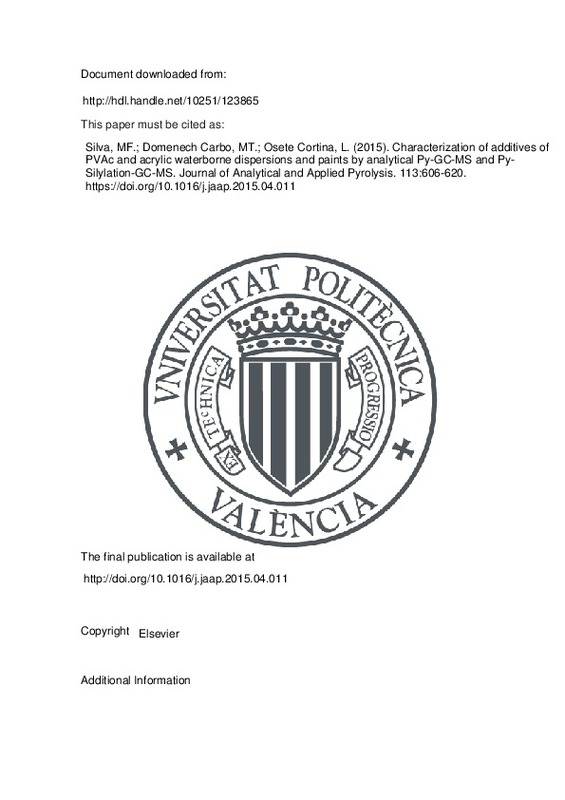JavaScript is disabled for your browser. Some features of this site may not work without it.
Buscar en RiuNet
Listar
Mi cuenta
Estadísticas
Ayuda RiuNet
Admin. UPV
Characterization of additives of PVAc and acrylic waterborne dispersions and paints by analytical Py-GC-MS and Py-Silylation-GC-MS
Mostrar el registro sencillo del ítem
Ficheros en el ítem
| dc.contributor.author | Silva, Miguel F.
|
es_ES |
| dc.contributor.author | Domenech Carbo, Mª Teresa
|
es_ES |
| dc.contributor.author | Osete Cortina, Laura
|
es_ES |
| dc.date.accessioned | 2019-07-20T20:02:10Z | |
| dc.date.available | 2019-07-20T20:02:10Z | |
| dc.date.issued | 2015 | es_ES |
| dc.identifier.issn | 0165-2370 | es_ES |
| dc.identifier.uri | http://hdl.handle.net/10251/123865 | |
| dc.description.abstract | [EN] Commercial formulations of poly(vinyl acetate) (PVAc) and acrylic dispersions and paints commonly used by artists include a number of additives such as surfactants, coalescing agents, defoamers and thickeners, which are designed for improving shelf-life, as well as chemical and physical properties of the resulting product. Recent studies have shown that additives present in paints play an important role in the alteration processes undergone by the painting during ageing and further in cleaning tasks planed in conservation interventions. However, the identification of additives is a difficult task due to the elusive character of these substances present at low concentration in the paint. In this context, a four-step approach is proposed that includes analysis of paint samples together with analysis of their water extracted products by pyrolysis-gas chromatography-mass spectrometry (Py-GC-MS) and pyrolysis-silylation-gas chromatography-mass spectrometry (Py-silylation-GC-MS). This analytical strategy enables a better characterization of common additives present in commercial PVAc and acrylic paints and dispersions. In particular, the analysis of water soluble extracts, which are mainly composed by paint additives, avoids the interference of the major polymer pyrolizates. Experimental conditions concerning sample preparation and instrumental working conditions of both Py-GC techniques are optimized. Both acrylic and PVAc paints presented poly(ethylene oxide) (POE) type fragments dominating the background of their pyrograms, especially when derivatized by means of hexamethyldisilazane (HMDS). For the first time, additives such as alkyl sulfate and alkyl ether sulfate with C-10 and C-12 alkyl chains, poly(ethoxylate) fatty alcohol and octylphenyl poly(ethoxylate) surfactants were identified, as well as polyvinyl alcohol (PVOH) protective colloids, hydrophobically modified ethoxylated urethane (HEUR) thickeners an defoamers. Their major fragments and corresponding mass spectra are discussed. (C) 2015 Elsevier B.V. All rights reserved. | es_ES |
| dc.description.sponsorship | Financial support from the MINECO Projects CTQ2011-28079-CO3-01 and CTQ2014-53736-C3-1-P, which are supported with ERDF funds, is gratefully acknowledged. | es_ES |
| dc.language | Inglés | es_ES |
| dc.publisher | Elsevier | es_ES |
| dc.relation.ispartof | Journal of Analytical and Applied Pyrolysis | es_ES |
| dc.rights | Reconocimiento - No comercial - Sin obra derivada (by-nc-nd) | es_ES |
| dc.subject | Additive | es_ES |
| dc.subject | PVAc | es_ES |
| dc.subject | Acrylic | es_ES |
| dc.subject | Waterborn dispersions | es_ES |
| dc.subject | Paints | es_ES |
| dc.subject | Pyrolysis-GC-MS | es_ES |
| dc.subject | Pyrolysis-silylation-GC-MS | es_ES |
| dc.subject.classification | PINTURA | es_ES |
| dc.title | Characterization of additives of PVAc and acrylic waterborne dispersions and paints by analytical Py-GC-MS and Py-Silylation-GC-MS | es_ES |
| dc.type | Artículo | es_ES |
| dc.identifier.doi | 10.1016/j.jaap.2015.04.011 | es_ES |
| dc.relation.projectID | info:eu-repo/grantAgreement/MINECO//CTQ2014-53736-C3-1-P/ES/APLICACION DE LAS TECNICAS NANOELECTROQUIMICAS Y BIOTECNOLOGIAS EN EL ESTUDIO Y CONSERVACION DEL PATRIMONIO EN METAL/ | es_ES |
| dc.relation.projectID | info:eu-repo/grantAgreement/MICINN//CTQ2011-28079-C03-01/ES/DESARROLLO DE METODOS NANOELECTROQUIMICOS DE ANALISIS DE OBRA PICTORICA BASADOS EN LA TECNICA DE MICROSCOPIA DE FUERZA ATOMICA-VOLTAMETRIA DE NANOPARTICULAS/ | es_ES |
| dc.rights.accessRights | Abierto | es_ES |
| dc.contributor.affiliation | Universitat Politècnica de València. Instituto Universitario de Restauración del Patrimonio - Institut Universitari de Restauració del Patrimoni | es_ES |
| dc.contributor.affiliation | Universitat Politècnica de València. Departamento de Conservación y Restauración de Bienes Culturales - Departament de Conservació i Restauració de Béns Culturals | es_ES |
| dc.description.bibliographicCitation | Silva, MF.; Domenech Carbo, MT.; Osete Cortina, L. (2015). Characterization of additives of PVAc and acrylic waterborne dispersions and paints by analytical Py-GC-MS and Py-Silylation-GC-MS. Journal of Analytical and Applied Pyrolysis. 113:606-620. https://doi.org/10.1016/j.jaap.2015.04.011 | es_ES |
| dc.description.accrualMethod | S | es_ES |
| dc.relation.publisherversion | http://doi.org/10.1016/j.jaap.2015.04.011 | es_ES |
| dc.description.upvformatpinicio | 606 | es_ES |
| dc.description.upvformatpfin | 620 | es_ES |
| dc.type.version | info:eu-repo/semantics/publishedVersion | es_ES |
| dc.description.volume | 113 | es_ES |
| dc.relation.pasarela | S\307296 | es_ES |
| dc.contributor.funder | Ministerio de Economía y Competitividad | es_ES |
| dc.contributor.funder | Ministerio de Ciencia e Innovación | es_ES |







![[Cerrado]](/themes/UPV/images/candado.png)

